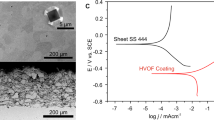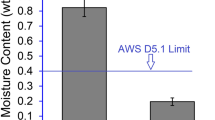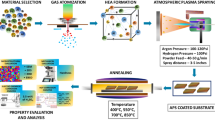Abstract
Modification of the surface properties of metals without affecting their bulk properties is of technological interest in demanding applications where surface stability and hardness are important. When austenitic stainless steel is heavily plastically deformed by grinding or rolling, a martensitic phase transformation occurs that causes significant changes in the bulk and surface mechanical properties1,2,3,4,5,6,7,8,9 of the alloy. This martensitic phase can also be generated in stainless-steel surfaces by cathodic charging, as a consequence of lattice strain generated by absorbed hydrogen10,11,12,13,14,15,16. Heat treatment of the steel to temperatures of several hundred degrees can result in loss of the martensitic structure1, but this alters the bulk properties of the alloy. Here we show that martensitic structures in stainless steel can be removed by appropriate electrochemical treatment in aqueous solutions at much lower temperature than conventional annealing treatments. This electrochemically induced annealing process allows the hardness of cold-worked stainless steels to be maintained, while eliminating the brittle martensitic phase from the surface. Using this approach, we are able to anneal the surface and near-surface regions of specimens that contain rolling-induced martensite throughout their bulk, as well as those containing surface martensite induced by grinding. Although the origin of the electrochemical annealing process still needs further clarification, we expect that this treatment will lead to further development in enhancing the surface properties of metals.
This is a preview of subscription content, access via your institution
Access options
Subscribe to this journal
Receive 51 print issues and online access
$199.00 per year
only $3.90 per issue
Buy this article
- Purchase on Springer Link
- Instant access to full article PDF
Prices may be subject to local taxes which are calculated during checkout


Similar content being viewed by others
References
Sumitomo, H. Investigation of the development of cold-rolling and annealing textures in SUS304 austenitic stainless steel. J. Iron Steel Inst. Jpn 77, 558–565 (1991).
Angel, T. Formation of martensite in austenitic stainless steel. J. Iron Steel Inst. 177, 165–174 (1954).
Ludwigson, D. C. & Berger, J. A. Plastic behaviour of metastable austenitic stainless steels. J. Iron Steel Inst. 207, 63–69 ( 1969).
Olson, G. B. & Cohen, M. Kinetics of strain-induced martensitic transformation. Metall. Trans. A 6, 791–795 (1975).
Olson, G. B. & Cohen, M. Stress-assisted isothermal martensitic transformation: application to TRIP steels. Metall. Trans. A 13, 1907–1914 (1982).
Huang, G. L., Matlock, D. K. & Krauss, G. Martensite formation, strain rate sensitivity and deformation behaviour of type 304 stainless steel sheet. Metall. Trans. A 20, 1239–1246 (1989).
Tomimura, K., Takaki, S. & Tokunaga, Y. Reversion mechanism from deformation induced martensite to austenite in metastable austenitic stainless steels. ISIJ Int. 31, 1431–1437 ( 1991).
Takaki, S., Tomimura, K. & Ueda, S. Effect of pre-cold-working on diffusional reversion of deformation induced martensite in metastable austenitic stainless steel. ISIJ Int. 34, 522–527 (1994).
Petersen, S. F., Mataya, M. C. & Matlock, D. K. The formability of austenitic stainless steels. J. Mater. 49, 54–58 ( 1997).
Bentley, A. P. & Smith, G. C. Phase transformation of austenitic stainless steels as a result of cathodic hydrogen charging. Metall. Trans. A 17, 1593– 1600 (1986).
Tähtinen, S., Kivilahti, J. & Hanninen, H. Crystallography of hydrogen-induced surface cracking in a spheroidal austenitic stainless steel single crystal. Scripta Metallurgica 19, 967–973 (1985).
Okada, H., Hosoi, Y. & Abe, S. Formation of cracks in austenitic stainless steels cathodically charged with hydrogen. Corrosion 26, 183– 186 (1970).
Ohtani, N., Asano, S., Fujishima, Y. & Yamamasu, Y. Hydrogen-induced transformation and embrittlement in 18-8 stainless steel. J. Jpn Inst. Metals 37, 746–753 (1973).
Narita, N., Altstetter, C. J. & Birnbaum, H. K. Hydrogen-related phase transformations in austenitic stainless steels. Metall. Trans. A 13, 1355 –1365 (1982).
Szummer, A. & Janko, A. Hydride phases in austenitic stainless steels. Corrosion 35, 461– 464 (1979).
Szummer, A. in Hydrogen Degradation of Ferrous Metals (eds Oriani, R. A., Hirth, J. P. & Smialowski, M.) 512–534 (Noyes Publications, Park Ridge, New Jersey, 1985).
Perng, T. P. & Altstetter, C. J. Effects of deformation on hydrogen permeation in austenitic stainless steels. Acta Metall. 34, 1771–1781 ( 1986).
Newman, R. C. & Burstein, G. T. Anion effects in the stress-corrosion cracking of copper and brass. J. Electrochem. Soc. 127, 2527 (1980).
Acknowledgements
We thank P.A. Midgley and M. Weyland for the TEM analysis. This work was supported by the EPSRC under the ROPA scheme.
Author information
Authors and Affiliations
Corresponding author
Rights and permissions
About this article
Cite this article
Burstein, G., Hutchings, I. & Sasaki, K. Electrochemically induced annealing of stainless-steel surfaces. Nature 407, 885–887 (2000). https://doi.org/10.1038/35038040
Received:
Accepted:
Issue Date:
DOI: https://doi.org/10.1038/35038040
This article is cited by
-
Magnetic force-assisted electrolytic machining for polycrystalline silicon
International Journal of Precision Engineering and Manufacturing (2015)
-
Wrap–bake–peel process for nanostructural transformation from β-FeOOH nanorods to biocompatible iron oxide nanocapsules
Nature Materials (2008)
-
The effect of electrochemically induced annealing on the pitting resistance of metastable austenite stainless steel
Metallurgical and Materials Transactions A (2006)
Comments
By submitting a comment you agree to abide by our Terms and Community Guidelines. If you find something abusive or that does not comply with our terms or guidelines please flag it as inappropriate.



